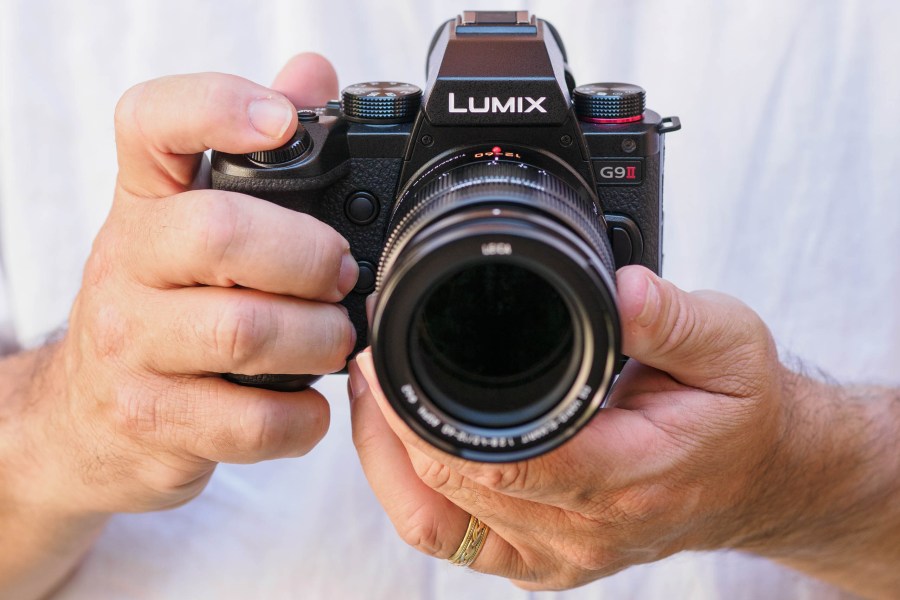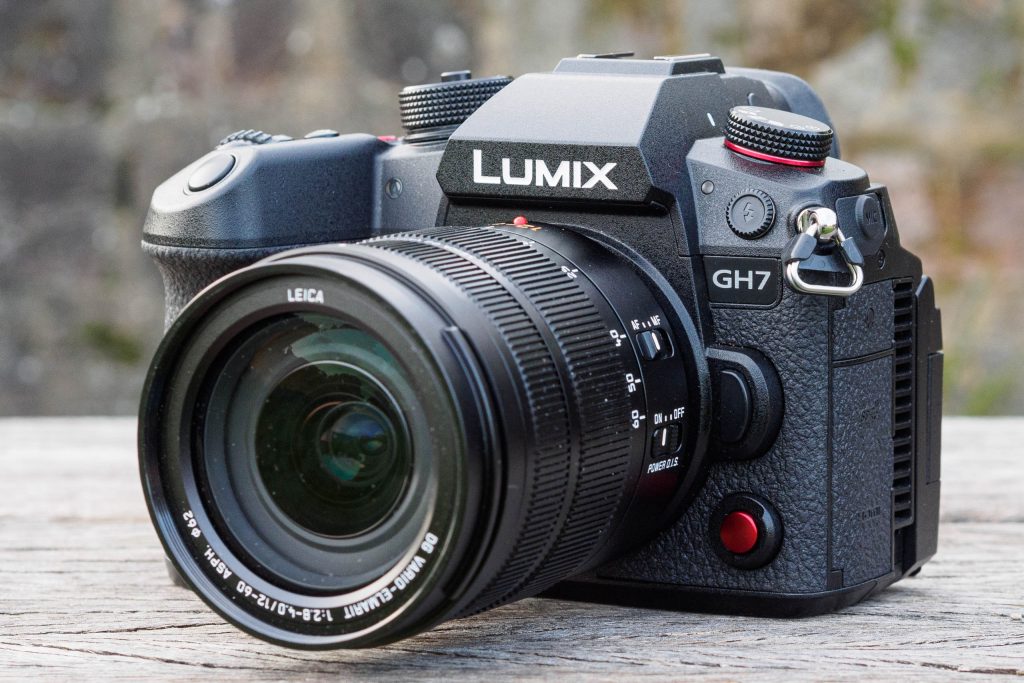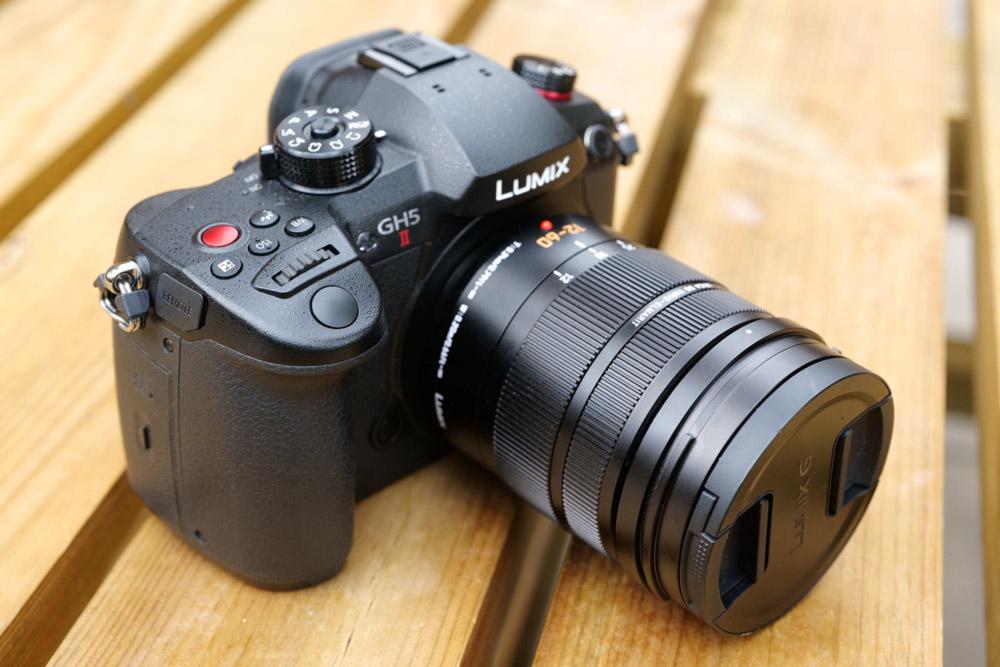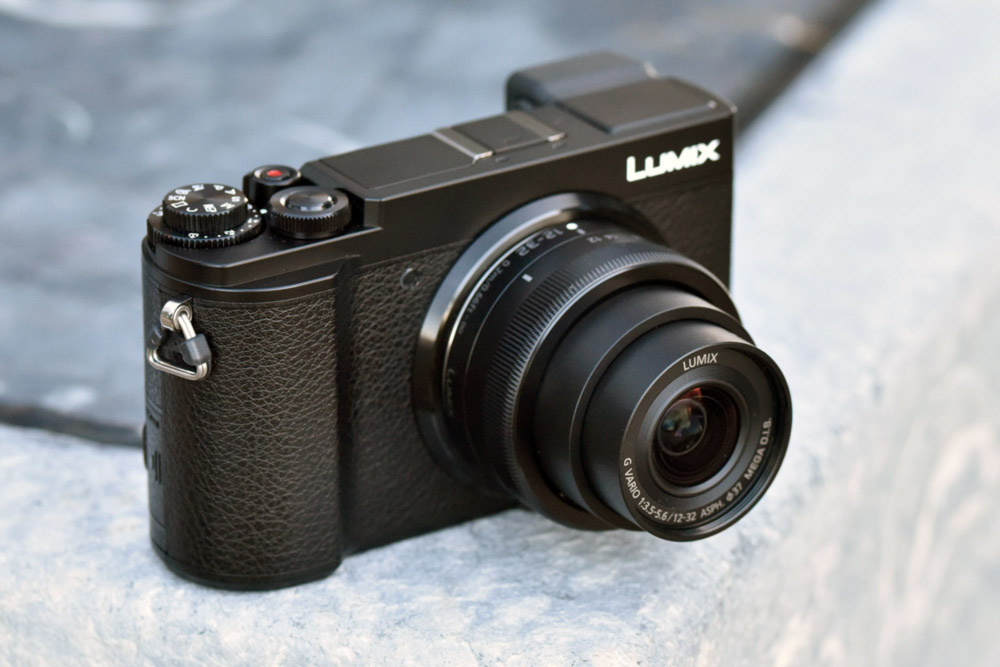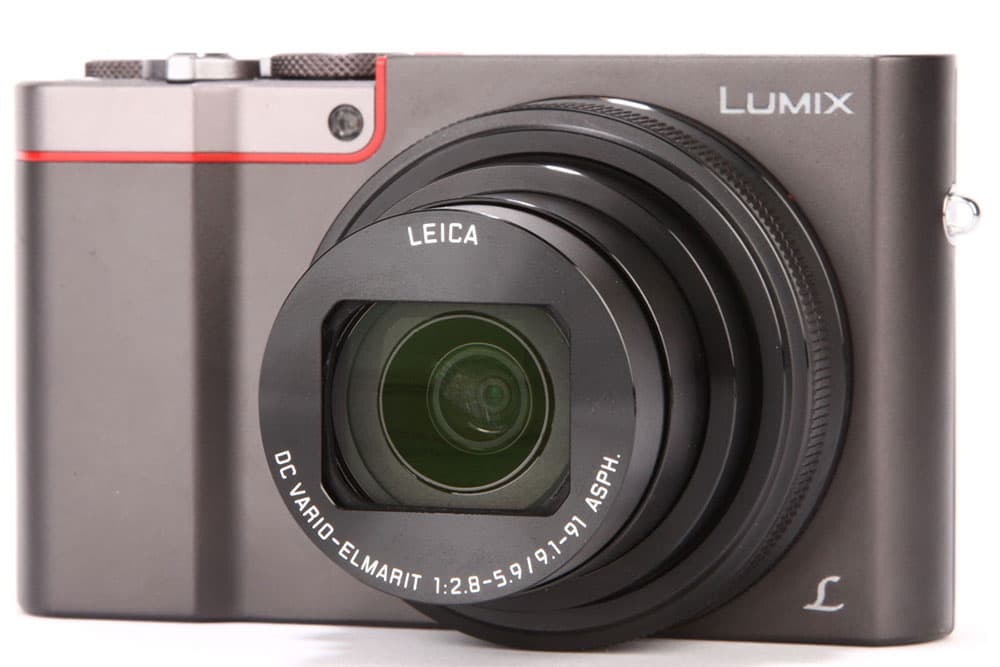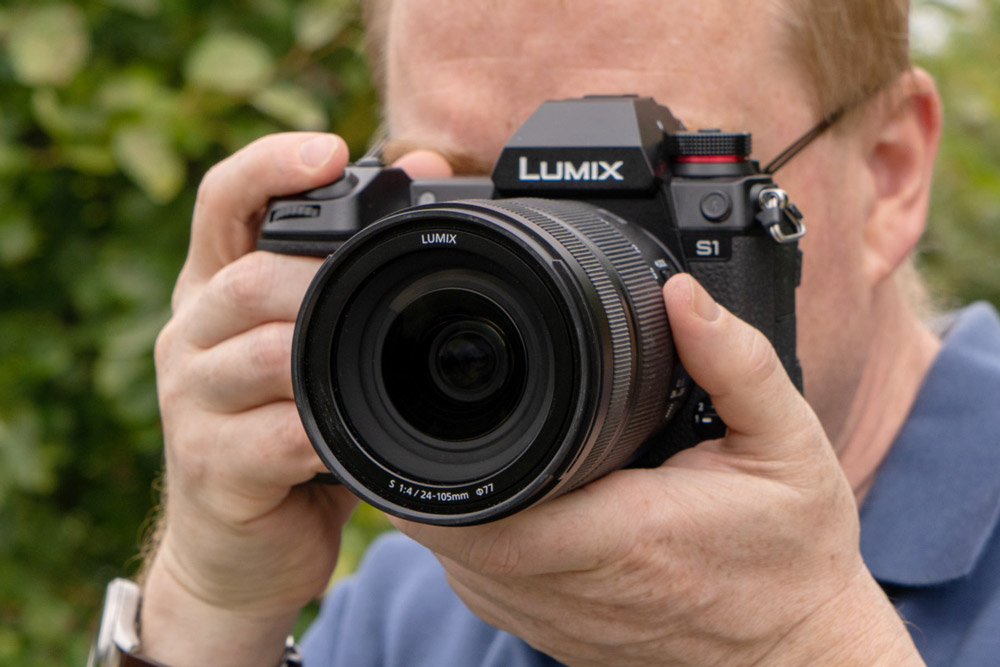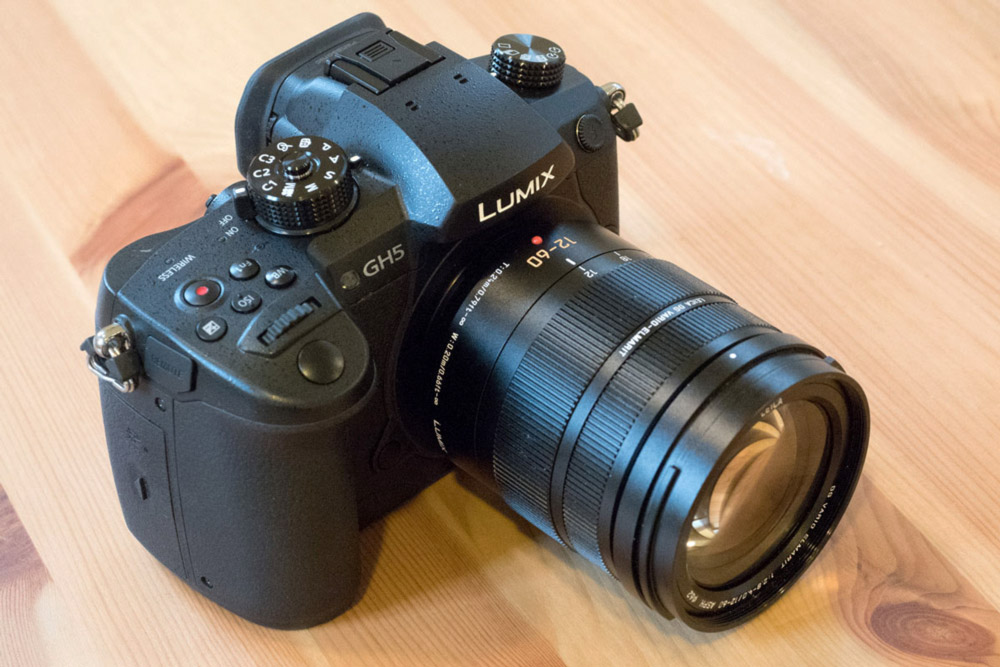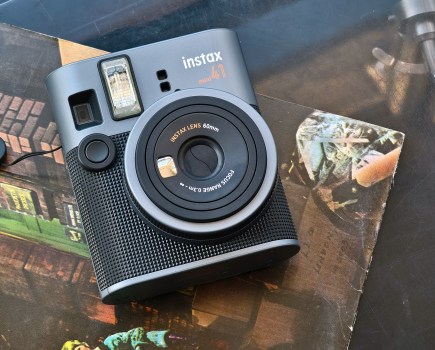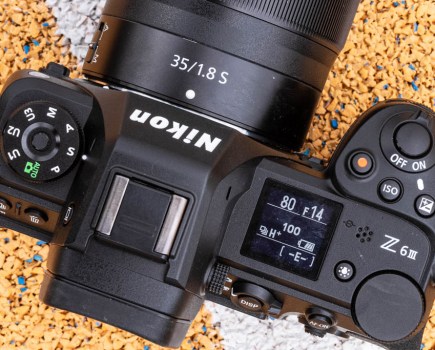The best Panasonic cameras have legions of admirers among photographers and videographers alike. With two mirrorless camera ranges and a suite of point-and-shoot compacts, Panasonic has built up a formidable portfolio of fantastic shooters. It was actually the first manufacturer out of the blocks with mirrorless; its pioneering Lumix G1 arrived way back in 2008. Since then, the firm has continued to grow from strength to strength, consolidating its lineup with the full-frame Lumix S series and solidifying its reputation as one of the best cameras for photography.
We test all the major cameras released by Panasonic; our list represents the models that have impressed our reviewers the most. With Panasonic courting both photographers and videographers, we assign video specialists to review new Lumix cameras as well as photo experts, so you’ll read the insights of different writers throughout this guide.
As mentioned, the Panasonic Lumix line-up includes Micro Four Thirds mirrorless, full-frame mirrorless and compact cameras, and we’ve included models from all these categories. There’s a section at the bottom of the page that explains these terms for those who are new to Panasonic gear.
Some budget-friendly options make the list, too. For more Micro Four Thirds options you may be interested in our guide to the best Olympus / OM System cameras, and we also have a dedicated rundown of the best full-frame mirrorless cameras that includes several Panasonic-made options.
The best Panasonic cameras: our quick list
Looking for the best deal on Panasonic cameras? Not only will you find the best Panasonic Lumix cameras, but also some of the best Panasonic camera deals, as our ‘Buy now’ buttons are set up to automatically take you to the best prices from trusted retailers. There is also a list of other retailers below each camera, so you can find the right deal for you.
Here are our picks of the best Panasonic cameras you can buy, with links to get the best prices…
- Best overall Panasonic camera: Panasonic Lumix G9II- Buy now
- Best full-frame Panasonic for video: Panasonic Lumix S5IIX- Buy now
- Best MFT Panasonic camera for video: Panasonic Lumix GH7 – Buy now
- Best Panasonic bridge camera: Panasonic Lumix FZ82D / FZ80D – Buy now
- Best Panasonic camera for vloggers: Panasonic Lumix GH5 II – Buy now
- Best entry-level Panasonic mirrorless camera: Panasonic Lumix G100D – Buy now
- Best mid-range Panasonic mirrorless camera: Panasonic Lumix G97 – Buy now
- Best rangefinder-style Panasonic mirrorless camera: Panasonic Lumix GX9 – Buy now
- Best entry-level Panasonic travel zoom: Panasonic Lumix TZ100 / ZS100 – Buy now
- Best full-frame Panasonic camera: Panasonic Lumix S5 – Buy now
- Best full-frame Panasonic camera for stills photography: Panasonic Lumix S1R – Buy now
- Best full-frame Panasonic camera to buy second-hand: Panasonic Lumix S1 – Buy now
- Best overall Panasonic camera to buy second-hand: Panasonic Lumix GH5 – Buy now
- Best Panasonic premium compact camera: Panasonic Lumix LX100 II – Buy now
Read on for a detailed breakdown of each camera, including pros and cons and our recommendations for which model is suited to you…
Why you can trust Amateur Photographer…
We spend many hours testing every product we recommend, in detail, in a variety of situations and shooting scenarios, and only use experts for our reviews, so you can be sure that you’re getting the best products. Find out more about our expert writers.
Best overall
Best overall Panasonic camera: Panasonic Lumix G9II
Amateur Photographer verdict
Aimed at serious enthusiasts this camera packs a lightweight portable body with an impressive feature set and image quality that will be hard to tell apart from full-frame models- Impressive subject detection autofocus system
- Excellent control layout
- Highly effective IBIS
- Improved image quality over older 20MP MFT cameras
- Control dials are under-employed out of the box
- Uninspiring colour output at default settings
Specifications at a glance:
| Sensor | 25.2MP Micro Four Thirds sensor |
| Continuous shooting | 75 fps AFS, 6-fps AFC |
| Autofocus | 779 phase detection AF points |
| ISO | ISO 50-25,600 (extended) |
| Image stabilisation | 8-stop 5-axis IBIS |
| Video | 5.7K 60p and 4K 120p video |
Namely, a successor to the Lumix G9, but it is more like a completely new camera with notable features such as phase detection autofocus instead of the older DFD (dept-from-defocus) system and automatic Dynamic Range Boost function. As well as Panasonic’s latest subject detection technology under the hood, it is one of the firm’s best cameras yet.
With a standard sensitivity range covering ISO 100-25,600, the sensor promises improved image quality compared to older 20MP MFT models, which had a base ISO of 200. The top shutter speed is 1/8000sec, or 1/32,000sec with the electronic shutter.
The hybrid phase detection/ contrast autofocus system delivers fast and accurate focusing and helps during video recording. Another one of the latest technologies employed is the subject detection autofocus for cars and motorcycles, so if you are a keen automotive photographer, the G9 may just be the camera for you. This coupled with 75 fps continuous shooting using the electronic shutter with fixed focus (60 fps with continuous AF) and you can be certain you won’t miss that eye-catching moment.
Read our full review of the Panasonic Lumix G9 II
Best full-frame for video
Best full-frame Panasonic for video: Panasonic Lumix S5IIX
Amateur Photographer verdict
The S5IIX is for people who have established themselves as creators and want a camera that will help them move further into the world of pro streaming and video.- Unlimited recording up to 6K/30p video
- Super steady IBIS
- Full size HDMI
- WIreless/wired streaming
- No CF Express slot
- Cropped in 4K/60p
Specifications at a glance:
| Sensor | 24.2MP full frame sensor |
| Continuous shooting | 30fps AFC with electronic shutter |
| Autofocus | 779-point Hybrid PDAF |
| ISO | ISO 50-204,800 (extended) |
| Image stabilisation | 5-axis IBIS |
| Video | 6K 30p |
The Lumix S5 II and Lumix S5II X are the first full frame Panasonic cameras that used phase detection autofocus instead of the firm’s slower proprietary Depth from Defocus (DFD) autofocus system.
The phase hybrid AF system combines phase detection for speed and contrast detection for accuracy, and 779 selectable AF points covering the entire frame. The subject detection modes include humans and animals. However, no vehicle tracking is added as with the Lumix G9 II.
The processing engine delivers an impressive 200 continuous RAW+JPEG images in burst mode before needing to buffer when using UHS-II U3 SD cards.
The S5II-series noteworthy features for video are the built in cooling fan and Active IS recording. The fan above the sensor allows for long video recording times without an external fan unit. The S5IIX shoots up to 4K, 3.3K and FHD resolution video with no limitations in recording time. The in body image stabilisation supports ‘Active IS‘ for video recording, which meant to provide greater shake compensation by ‘anticipating’ and compensating for the up down motion associated with walking and allows smoother motion when tilting and panning.
Read our full review of the Panasonic Lumix S5II X
Best MFT for video
Best MFT Panasonic camera for video: Panasonic Lumix GH7
Amateur Photographer verdict
A superb hybrid camera for both stills and video. It offers the same excellent handling and advanced video features as the GH6, but gains significantly improved autofocus.- Transformed autofocus thanks to phase detection and updated subject recognition
- Excellent handling and control layout
- Superb in-body image stabilisation
- Vast range of video formats and high-end features
- Practically unlimited video recording times
- No automatic subject-type selection
- Lower dynamic range than larger-sensor cameras
- Slightly bulky body
Specifications at a glance:
| Sensor | 25.2MP BSI-CMOS Four Thirds-type sensor |
| Continuous shooting | 75fps |
| ISO | ISO 100-25,600 (standard) |
| Image stabilisation | 7.5 stops |
| Video | 5.7K 60p, C4K 120p, FHD 240p video |
With Panasonic’s S series range of full frame cameras hogging the limelight in recent years, some predicted that the company’s Lumix G series, which uses far smaller Micro Four Thirds sensors, would fade into irrelevance.
The Panasonic Lumix GH6 banished such notions as a hugely impressive hybrid offering professional-level cinema camera features and performance at a price no rival could match. Relatively compact, user-friendly and easy to handle, it’s a hugely powerful creative tool for filmmakers, and solid for still photography too.
The new GH7 is all this and more: crucially, with the addition of Panasonic’s phase detection autofocus. Furthermore, its subject recognition system gains the ability to recognise trains and planes, bringing it closer into line with other brands. For video there’s now ProRes support, plus enhanced audio recording via the new DMW-XLR2 mic adapter.
Read our Panasonic Lumix GH7 review
Best bridge camera
Best Panasonic bridge camera: Panasonic Lumix FZ82D / FZ80D

Amateur Photographer verdict
Long on zoom and short on price, the Panasonic Lumix FZ82D / FZ80D (name varies by territory) is an inexpensive all-in-one camera that’s well-suited to travel and holidays.- 60x zoom lens
- Good-quality EVF
- 4K Photo modes
- Old-fashioned 18MP 1/2.3-inch sensor
- No built-in Wi-FI
Specifications at a glance:
| Sensor | 18.1MP 1/2.3-inch CMOS sensor bridge camera |
| Lens | 20-1200mm equivalent f/2.8-f/5.9 lens (60x optical zoom), OIS |
| ISO | ISO 80-6,400 (extended) |
| Image stabilisation | Power OIS |
| Video | 4K/30p |
Many photographers had assumed that Panasonic was just about done producing bridge cameras — long-zoom, SLR-styled compact cameras. However, July 2024 saw the release of the Lumix FZ82D (FZ80D in the US), a brand new bridge replacing the FZ80. Sure, the innards are mostly the same, with an 18.1MP 1/2.3-inch MOS sensor that looks dated compared even to modern smartphones. However, the FZ82D has one major thing going for it compared to other bridge cameras — availability. And you won’t catch many smartphones with a 60x optical zoom lens.
It’s fairly lightweight despite that big lens, making the Lumix FZ82D an excellent choice of camera for travel. You get that proper SLR-style “heft” without being weighed down too much, and it must be said that the experience of shooting on a proper camera with a grip and a physical shutter button remains infinitely better than that of a phone. Image quality is fine, if a little muted and drab in some situations. You’ll find that the lens does well in even daylight, and struggles in more challenging situations — bright sun, for instance, can cause some very unattractive flare.
The FZ82D requires some willingness to work within its limitations. However, its price point puts it much cheaper than not just cameras, but also most phones, and the versatility it gives you thanks to that big lens is undeniable.
Read our full Panasonic Lumix FZ82D / FZ80D review
Best for vlogging
Best Panasonic camera for vloggers: Panasonic Lumix GH5 II
Amateur Photographer verdict
A true hybrid camera, aimed for vloggers with live streaming capability directly from camera via app or tethering- Pro video features
- Full-size HDMI output
- Can be powered by USB-C
- Live streaming capabilities
- Limited ISO sensitivity
- Outdated AF system
Specifications at a glance:
| Sensor | 20.3 Live MOS Micro Four Thirds sensor |
| Continuous shooting | 12fps AFS, 9fps AFC |
| ISO | ISO 100-25,600 (extended) |
| Image stabilisation | 6.5-stop |
| Video | 4K 60p (4:2:0 10-bit), Wireless and wired live streaming |
The long-awaited follow-up to the beloved GH5, the Panasonic Lumix GH5 II is, like its predecessor, a flexible all-rounder with plenty for both videographers and photographers to like. It has a video emphasis, with its wide range of codecs, frame rates, resolutions and more to choose from making it a pro-level choice – even if the launch of the GH6 a few months later took the shine off somewhat. We think most filmmakers would do better spending a little extra to get the more powerful GH6, but beyond the obvious greater affordability the GH5 II does have a couple of advantages over its big brother: it supports video live streaming and it’s around 100g lighter.
That makes it a good choice as a vlogging camera (its 6.5-stop 5-axis IBIS, full-size HDMI, vari-angle screen and ability to run via USB-C power delivery are appealing in this regard too), and content creators will also welcome its photography skills (including 6K/4K Photo) when making thumbnails and other still images.
If the GH5 II has weaknesses, it’s that it uses a contrast-detection autofocus system rather than a more advanced hybrid setup (not a deal-breaker by any means) and that its limited ISO range means it’s not a fantastic performer in low light conditions.
Check out our list to the best zoom lenses for Micro Four Thirds.
Read our Panasonic Lumix GH5 II review
Best entry-level
Best entry-level Panasonic mirrorless camera: Panasonic Lumix G100D
Amateur Photographer verdict
The G100 was a beginner friendly, affordable MFT hybrid shooting good-quality photos and video – this minor update adds a USB-C port and new viewfinder.- Excellent value for money
- USB-C connectivity
- Good handling for its small size
- OLED viewfinder
- Heavy crop with electronic stabilisation
- 4K clips limited to 10 minutes
Specifications at a glance:
| Sensor | 20.3MP MOS Micro Four Thirds sensor |
| Continuous shooting | 6fps AFS, 5fps AFC |
| ISO | ISO 200-25,600 (expandable to ISO 100-25,600) |
| Image stabilisation | 5-axis HYBRID I.S. |
| Video | 4K 30p |
The original Panasonic Lumix G100 was the cheapest mirrorless model in the company’s entire range, aimed chiefly at younger photographers and vloggers upgrading from smartphones to dedicated camera gear. Small and lightweight (just 345g without a lens), the G100 boasted a number of vlogger-friendly features, and also a high-quality electronic viewfinder to appeal to photographers. One annoyance, however, was that its connectivity port used the ageing micro USB interface rather than the faster and more robust USB-C.
Panasonic has now corrected this with the release of the updated Lumix G100D, a camera that’s essentially identical, but adds USB-C connectivity. No doubt this was at least partly motivated by the EU common charger directive set to come into force at the end of 2024. However, the manufacturer also took the opportunity to improve the electronic viewfinder on the Lumix G100D. It’s now an OLED rather than an LCD. While the resolution is lower than it was – at 2.36 million dots rather than 3.68 million – the OLED upgrade makes for an overall better experience.
Otherwise, this is very similar to the original G100 that first impressed our reviewer. It’s easy to handle and use, with a large grip on the front and thumb rest at the rear. Buttons and dials are thoughtfully located, while the rear screen can be tilted and flipped to face forward, making the camera ideal for vlogging and selfies. The G100D can record 4K footage at up to 30fps, and stabilise it too – although it does this electronically rather than optically. This results in a severe 1.8x crop when shooting 4K. 4K clips are also limited to 10 minutes in length, but if you can work around these limits you’ll find this to be a solid all-rounder at a really competitive price.
Read our Panasonic Lumix G100 review
Best mid-range
Best mid-range Panasonic mirrorless camera: Panasonic Lumix G97
Amateur Photographer verdict
A good, solidly constructed mid-range Micro Four Thirds camera, the Panasonic Lumix G97 brings you into a well established system.- Effective IBIS
- Weather-sealed construction
- Improved fully articulating screen
- Single card slot
- Minor update from G90
- Fairly big for MFT
Specifications at a glance:
| Sensor | 20.3MP Live CMOS Micro Four Thirds sensor |
| Continuous shooting | 9fps AFS, 6fps AFC |
| ISO | ISO 100-25,600 (extended) |
| Image stabilisation | 5 stops |
| Video | 4K 30p |
The hybrid Panasonic G97 represents an affordable all-rounder option for both stills and video as it delivers solid performance across photo and video. It’s a rugged, weatherproof camera with a DSLR-style shape and comfy handling that shares the same sensor as the higher-end Panasonic G9. It features IBS that adds up to 5 stops of compensation when shooting handheld, whether the lens you are using has its own stabilisation or not.
Able to record 4K video at up to 30fps (and output 8-bit 4:2:2 video to an external recorder via micro HDMI) and equipped with an updated 1.8m dots touchscreen that can be flipped and twisted to face fully forwards, it’s clear that the G97 has been made with vloggers in mind Image quality is solid across the board.
For those who like both stills and video, it’s a great all-rounder, while it’s (relative) lightweight and small it also has lots of compatible Micro Four Thirds lenses available which make it ideal for travel.
Read our Panasonic Lumix G97 review
Best rangefinder
Best rangefinder-style Panasonic mirrorless camera: Panasonic Lumix GX9
Amateur Photographer verdict
A very powerful yet portable compact rangefinder that packs impressive specifications into a small body.- Compact, portable design
- Effective IBIS
- Quiet shutter allows discreet shooting
- Awkward default controls with EVF shooting
- 16:9 viewfinder doesn’t match sensor well
- Not weather-sealed
Specifications at a glance:
| Sensor | Compact camera with 20.3MP Live MOS Micro Four Thirds sensor |
| Continuous shooting | 9fps AF-S, 6fps AF-C |
| ISO | ISO 100-25,600 (extended) |
| Image stabilisation | 5-axis Dual IS |
| Video | 4K 30p |
While most of Panasonic’s mirrorless models get their design cues from DSLRs, the company also does a small line of rangefinder-style camera bodies. The Panasonic Lumix GX9 is one of these, with a flatter, slimmer profile, no large hand grip and no central ‘bump’ to house its EVF and hot shoe. Instead there’s a tiny bump for the right hand to wrap around, with the hot shoe and viewfinder incorporated right into the main body. The viewfinder and screen do tilt, though, giving them extra flexibility, and there’s room for IBIS, which is impressive in such a compact body. The small size and quiet operation makes this a good model for street photography.
The cramped design does cause some handling issues and the default control layout is awkward and poorly thought-out. Users can customise controls to ameliorate this somewhat, but Panasonic should be doing better. The 16:9 ratio viewfinder is another odd touch; it suits video shooting well, but wastes lots of space when it comes to still photography.
Read our Panasonic Lumix GX9 review
Best travel zoom
Best entry-level Panasonic travel zoom: Panasonic Lumix TZ100 / ZS100
Amateur Photographer verdict
A pocket-sized compact camera with a decent sensor and super zoom reach, perfect for travel photography- Impressive zoom range covers everything
- Good 1-inch sensor quality
- Generous ISO range
- Slim, pocketable body
- Narrow max aperture
Specifications at a glance:
| Sensor | Compact camera with 1-inch 20.1MP sensor |
| Lens | 25-250mm equivalent f/2.8-5.9 Leica DC lens |
| ISO | ISO 80-25,600 (extended) |
| Image stabilisation | Hybrid 5-axis optical/electronic image stabilisation |
| Video | 4K 30p |
Deservedly, the Panasonic Lumix TZ cameras (or Lumix ZS if you’re in the US) are some of the most popular travel zooms around. While the Lumix TZ100 is not the biggest, flashiest or newest, we reckon its combination of intuitive controls, a big zoom range, a pocketable body and a friendly price tag (even more so since release) make it the best choice for most users.
Covering a huge zoom range from a wide 25mm to a considerably telephoto 250mm, the Lumix TZ100 can shoot pretty much anything. What’s more, its 1-inch sensor (an upgrade from previous TZ cameras) means you’ll notice a tangible difference in image quality compared to your smartphone. Just be aware that the lens aperture of f/2.8-5.9 is pretty modest, meaning you might sometimes struggle to get sharp shots when the light goes low. Though the Hybrid 5-axis optical/electronic image stabilisation does help somewhat in this department, as we noted in our full review of the camera back when it was released.
The future of compact cameras is uncertain, and we may not get many – or any – more TZ cameras after the latest TZ200, which adds a longer zoom than the TZ100, at the cost of an even narrower maximum aperture. Still, as long as the Lumix TZ100 is still available, new or used, we’ll keep recommending it to anyone who’s looking for a well-made travel zoom camera.
Read our Panasonic Lumix TZ100 / ZS100 review
Best full-frame
Best full-frame Panasonic camera: Panasonic Lumix S5
Amateur Photographer verdict
A practical all-rounder in terms of its size and weight and enjoyable to use. A good alternative to some of the other fine full-frame mirrorless cameras out there under £2000- Smallest, lightest Panasonic full-frame camera
- Excellent handling and controls
- Rugged, weather-proof body
- Wide range of video options
- Only one high-speed card slot
- Some controls feel plasticky
Specifications at a glance:
| Sensor | 24.2MP full-frame CMOS sensor |
| Continuous shooting | 7fps AF-S, 5fps AF-C |
| ISO | ISO 100-51,200 (expandable to 50-204,800) |
| Image stabilisation | Up to 6.5 stops, Dual IS2 IBIS with compatible lens |
| Video | 4K 60p/50p 4:2:0 10-bit |
Panasonic is still a relative newcomer to the full-frame game, with its L Mount range only arriving in 2019. Of the handful of L Mount cameras we’ve reviewed thus far, the Panasonic Lumix S5 has the most overall appeal, and that’s mostly down to its relatively compact, lightweight size and excellent DSLR-style handling, for which there is little compromise to performance or features. In fact, autofocus feels snappier here than on the S1 and S1R, despite the general image quality being on a par with the (much larger) S1.
The S5 comes with IBIS to stabilise any attached lens, a rugged and weather-sealed magnesium alloy build and a wide range of options for videographers including HDR, V-Log and S&Q (slow and quick) recording, RAW output and the ability to use anamorphic lenses and (with Panasonic’s adapter) pro-level microphones. That you get all this in a body that’s compact and lightweight feels like the S5 is Panasonic properly finding its full-frame feet – and hopefully a taste of even better things to come in the range. As mentioned above, Panasonic recently announced the S5 II, featuring phase detection AF – full review to follow.
Read our Panasonic Lumix S5 review
Best for stills
Best full-frame Panasonic camera for stills photography: Panasonic Lumix S1R
Amateur Photographer verdict
Delivers top notch image quality, and highly effective image stabilisation in a robust well built body, however it’s on the heavy-side compared to its counterparts- Amazingly detailed images
- Superb electronic viewfinder
- Effective IBIS
- Rugged, pro-level build quality
- As large and heavy as a full-frame DSLR
- Slow autofocus in poor lighting
Specifications at a glance:
| Sensor | 47.3MP full-frame CMOS sensor |
| Continuous shooting | 9fps AF-S, 6fps AF-C |
| ISO | ISO 100-25,600 (expandable to 50-51,200) |
| Image stabilisation | 5-axis In-body Dual IS2 |
| Video | 4K 60p |
Along with the S1, the Panasonic Lumix S1R was the vanguard of Panasonic’s 2019 arrival in the full-frame mirrorless market. A few years on, this large and bulky camera (which offers almost no size or weight advantage over a full-frame DSLR) is less likeable than the newer, cheaper, more compact S5, but does have one major advantage: its high-resolution sensor, with a pixel count of 8368 x 5584. This of course captures beautifully sharp images at its 47.3MP native resolution, but via clever stitching can also create truly stunning 187MP shots. The S1R is less video-centric than either the S5 or S1, but can record 4K at up to 60fps too.
In design, it’s every bit the premium enthusiast’s camera it set out to be. The body is rugged and weather-sealed and the 5.76-million dot electronic viewfinder may well be the sharpest and punchiest of any current camera on the market. The IBIS is effective; the autofocus less so, feeling particularly hesitant in low light.
Read our Panasonic Lumix S1R review
Best used full-frame
Best full-frame Panasonic camera to buy second-hand: Panasonic Lumix S1
Amateur Photographer verdict
A highly accomplished camera that’s a strong competitor to its 24MP rivals, solidly built and handles exceptionally well- Superb EVF
- IBIS
- Rugged build
- Thoughtful control layout
- Large and heavy
- AF faster on cheaper S5
Specifications at a glance:
| Sensor | 24.2MP full-frame CMOS sensor |
| Continuous shooting | 9fps AF-S, 6fps AF-C |
| ISO | ISO 100-51,200 (expandable to 50-204,800) |
| Image stabilisation | 5-axis In-body Dual IS2, sensor shift image stabilisation |
| Video | 4K 60p |
The Panasonic Lumix S1 was one of the first full-frame cameras made by the company, and the arrival of the S5 has seen its appeal fade. That’s not to say this isn’t an impressive camera in its own way, benefitting from a healthy selection of video shooting options, impressive 5-axis IBIS, rock-solid (and weatherproof) build quality and thoughtful position of its controls, which puts everything important at your fingertips.
It does have some slight advantages over the S5 too, in the form of faster continuous shooting and a sharper, clearer EVF. Now that it’s available at a cheaper price than launch and widely available used, that does make it a potentially tempting buy over the S5 – if only in certain circumstances.
The S1’s heft and size are an issue, though: with a premium lens attached it’s just as large and heavy as a full-frame DSLR, which immediately eliminates one of the main advantages of choosing a mirrorless full-frame camera.
Read our Panasonic Lumix S1 review
Best used MFT
Best overall Panasonic camera to buy second-hand: Panasonic Lumix GH5
Amateur Photographer verdict
An affordable choice if you are looking for good video quality, image stabilisation in an easy to handle package.- Video performance still impressive today
- Superb handling and control layout
- Clear viewfinder
- 5-axis IBIS
- Noisy images at high ISO
- Heavy by Lumix G standards
- GH5 II and GH6 now better for video
Specifications at a glance:
| Sensor | 20.3MP Live MOS Micro Four Thirds sensor |
| Continuous shooting | 9fps AF-C |
| ISO | ISO 100-25,600 (extended) |
| Image stabilisation | 5 stops, 5-axis Dual IS 2 IBIS |
| Video | 10-bit 4:2:2 4K video recording |
When it comes to video-focused Lumix G series cameras, the Panasonic Lumix GH5 has now been superseded by both the GH5 II and the GH6. Panasonic has retained it as a current range model, however, and while we don’t think you should buy it brand-new over either of the aforementioned models, its age and popularity make it readily available and affordable as a second-hand purchase.
The GH5 is something of a modern classic, prized for being one of the first small mirrorless cameras to deliver a professional 4K video recording experience alongside strong still photography performance. With IBIS and a clear, detailed EVF on board, as well as excellent handling and a user-friendly control layout, it remains an impressive hybrid model today, particularly for multi-disciplinary content creators who want to dabble in both movies and photos without major compromise. If you can pick it up cheaply used or refurbished, it’s a fantastic camera with bags of creative potential.
Read our Panasonic Lumix GH5 review
Best premium compact
Best Panasonic premium compact camera: Panasonic Lumix LX100 II
Amateur Photographer verdict
It will appeal strongly to enthusiast photographers looking for a small camera that isn’t merely a point and shoot- Large sensor in a compact body
- Versatile, fast lens
- Engaging manual controls
- Unarticulated screen
- Lens prone to flare when shooting into sun
Specifications at a glance:
| Sensor | Compact camera with 17MP Four Thirds MOS sensor |
| Lens | 24-75mm f/1.7-2.8 lens |
| ISO | ISO 100-25,600 (extended) |
| Image stabilisation | OIS |
| Video | 4K30p |
Despite being several years old, the Panasonic Lumix LX100 II remains a fantastic premium compact that puts mirrorless-level performance in a lightweight and affordable fixed zoom lens device. Compact enough to fit in a jacket pocket and just 393g, it has a large sensor and wide maximum aperture of f/1.7-2.8 (depending on your focal length) allowing it to keep shutter speeds fast and low light performance impressive.
Its standard zoom range can handle most types of shot you might want to take, making this a fine choice for travelling rather than cart about a body and several lenses. It can also record 4K video (with a slight crop), but the unarticulated screen does restrict its use as a vlogging tool.
The LX100 II was released in 2018, making it high time for Panasonic to unveil a replacement. Until it does, this remains the company’s most desirable compact camera, and one that you should be able to find used or refurbished for even less than its MSRP.
Read our Panasonic Lumix LX100 II review
How to choose the best Panasonic camera
Before buying a Panasonic camera there are a number of features and functions to consider.
Firstly, what type of camera are you looking for? If it’s one with a smaller sensor, smaller body, smaller lenses and (typically) a smaller price tag, then a Lumix G series mirrorless camera or a premium Lumix compact camera will probably best suit your needs. Panasonic’s mirrorless cameras are part of the Micro Four Thirds system, and will take any of the best Micro Four Thirds lenses, as well as the best Micro Four Thirds zoom lenses.
If you have a larger budget and expect better image quality, particularly in challenging situations like low light, then a full-frame Lumix S series mirrorless camera might be more your speed. With larger sensors and high-quality lenses, Panasonic’s S series models are generally larger, heavier and more expensive than their G series cousins, pitched towards serious enthusiasts and professionals in both photo and video.
Other things to consider apply across all types of Panasonic cameras. ISO is a measure of light sensitivity (with higher ISO models generally working better in low light conditions), while autofocus and continuous shooting speed are important considerations for those looking to photograph fast-moving subjects like sport or wildlife.
Another thing to look out for is in-body image stabilisation, or IBIS. Many Panasonic cameras offer this, which ensures some measure of motion compensation, no matter which lens is attached – a key boon when shooting videos or photos handheld, or when using longer exposures in low light. Some cameras without IBIS still get the benefit of image stabilisation, but it might be digital-based (which results in a forced crop), or dependent on the lens attached.
Contemporary Panasonic cameras shoot 4K video as a matter of course, and also benefit from clever 4K Photo modes that allow you to extract high-quality stills from the footage. Pretty much whichever Panasonic camera you choose, you’re going to get a solid video shooter – however there are some particular models, like the Lumix GH series, that are particularly well-optimised for filmmakers.
If you’re still deciding on the type of camera you want to buy, check out our guide to DSLR vs mirrorless: which is best.
How we test Panasonic cameras
We test Panasonic cameras primarily by using them to take photographs and video in a wide range of real-world situations. We evaluate their control layouts and handling, and the usability of their viewfinders and screens. We assess their autofocus across a range of different subjects and shooting scenarios and check their continuous shooting capabilities.
We also examine the effectiveness of their image stabilisation systems. Last but by no means least, we critically evaluate the image quality, in both JPEG and raw, including resolution, high-ISO noise, and dynamic range. We then take all these factors into account, along with such things as portability and lens systems, when giving our final conclusion and score. You’ll find the full breakdown of how each camera has performed in our full reviews.
Original article by Sam Kieldsen, with contributions from AP staff.
If you’re going for a Micro Four Thirds camera, make sure you have a look at the best Micro Four Thirds lenses available. For more options, have a look at our latest buying guides, and reviews.

